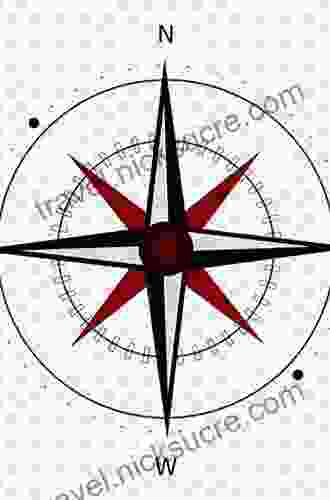Flying North South East and West: An Exploration of Directionality in the Skies


Directionality plays a crucial role in aviation, guiding pilots and aircraft along their intended paths. From the soaring heights of the sky to the vast expanse of the Earth below, the ability to navigate effectively is paramount for safe and efficient air travel. This article will delve into the fundamentals of flying north, south, east, and west, exploring the techniques, technologies, and challenges involved in each direction.
4.6 out of 5
| Language | : | English |
| File size | : | 9259 KB |
| Text-to-Speech | : | Enabled |
| Screen Reader | : | Supported |
| Enhanced typesetting | : | Enabled |
| Word Wise | : | Enabled |
| Print length | : | 254 pages |
| Lending | : | Enabled |
Flying North
Flying north involves ascending vertically and then maintaining a heading towards the North Pole. This direction is typically used for long-distance flights over polar routes, which can offer shorter distances compared to equatorial routes. Pilots rely on magnetic compasses and inertial navigation systems (INS) to maintain a northerly course.
Magnetic compasses detect the Earth's magnetic field and align themselves with magnetic north, which is different from true north. INS, on the other hand, uses accelerometers and gyroscopes to calculate aircraft attitude and position, providing a more accurate and reliable navigation system.
Challenges of flying north include strong headwinds and extreme cold temperatures, especially in high-latitude regions. Pilots must be prepared for icing conditions and potential deviations from their planned route due to weather or magnetic anomalies.
Flying South
Flying south entails descending vertically and then maintaining a heading towards the South Pole. This direction is often used for flights from the Northern Hemisphere to the Southern Hemisphere and vice versa.
Similar to flying north, pilots employ magnetic compasses and INS to navigate their southbound course. However, they must consider tailwinds and monitor fuel consumption carefully to ensure sufficient range for the flight.
Challenges of flying south include potential encounters with the Intertropical Convergence Zone (ITCZ),an area of low atmospheric pressure and frequent thunderstorms. Pilots must also be aware of directional shifts due to the curvature of the Earth and adjust their heading accordingly.
Flying East
Flying east involves maintaining a constant heading towards a longitude line east of the aircraft's starting point. This direction is commonly used for long-distance flights across oceans or continents.
Unlike flying north or south, which require vertical movement, flying east primarily involves maintaining a constant altitude and direction. Pilots use a combination of magnetic compasses, INS, and GPS (Global Positioning System) to stay on track.
Challenges of flying east include strong winds and the need for precise navigation over long distances. Pilots must continuously monitor their position and make corrections to maintain their intended course, especially when flying over remote areas with limited navigation aids.
Flying West
Flying west entails maintaining a constant heading towards a longitude line west of the aircraft's starting point. This direction is often used for flights returning from the Eastern Hemisphere to the Western Hemisphere.
Similar to flying east, flying west primarily involves maintaining a constant altitude and direction. However, pilots must be aware of potential tailwinds and adjust their fuel consumption accordingly.
Challenges of flying west include staying within the designated airspace and avoiding conflicts with other aircraft. Pilots must also consider the effects of time zones and coordinate with air traffic control to ensure a smooth and safe flight.
Understanding directionality in aviation is essential for pilots to navigate the skies effectively and safely. Flying north, south, east, and west requires precise navigation techniques, a thorough understanding of weather patterns, and the ability to overcome challenges along the way.
As technology continues to advance, new and innovative navigation systems will emerge, enhancing the precision and safety of air travel. However, the fundamentals of directionality will remain a cornerstone of aviation, ensuring that aircraft and passengers reach their destinations on time and without incident.
4.6 out of 5
| Language | : | English |
| File size | : | 9259 KB |
| Text-to-Speech | : | Enabled |
| Screen Reader | : | Supported |
| Enhanced typesetting | : | Enabled |
| Word Wise | : | Enabled |
| Print length | : | 254 pages |
| Lending | : | Enabled |
Do you want to contribute by writing guest posts on this blog?
Please contact us and send us a resume of previous articles that you have written.
 Fiction
Fiction Non Fiction
Non Fiction Romance
Romance Mystery
Mystery Thriller
Thriller SciFi
SciFi Fantasy
Fantasy Horror
Horror Biography
Biography Selfhelp
Selfhelp Business
Business History
History Classics
Classics Poetry
Poetry Childrens
Childrens Young Adult
Young Adult Educational
Educational Cooking
Cooking Travel
Travel Lifestyle
Lifestyle Spirituality
Spirituality Health
Health Fitness
Fitness Technology
Technology Science
Science Arts
Arts Crafts
Crafts DIY
DIY Gardening
Gardening Petcare
Petcare Karen Robards
Karen Robards Peter Crouch
Peter Crouch J D Kraus
J D Kraus Shaun Morey
Shaun Morey Jo Kessel
Jo Kessel Sally Lewis
Sally Lewis Ben Doughty
Ben Doughty Newest Edition Kindle Edition
Newest Edition Kindle Edition Michael Gass
Michael Gass Paul Seftel
Paul Seftel Sarah Woodbury
Sarah Woodbury Napoleon Hill
Napoleon Hill Anasazi Foundation
Anasazi Foundation Kenneth M Adams
Kenneth M Adams Osborne Russell
Osborne Russell L Waithman
L Waithman Pieter Arend Folkens
Pieter Arend Folkens Amy Mills
Amy Mills Jen Stevenson
Jen Stevenson Joe Loughran
Joe Loughran Bethany Griggs
Bethany Griggs Ancient Wisdom Books
Ancient Wisdom Books Amy Lang Ma
Amy Lang Ma Samantha Rodman
Samantha Rodman Michael Cabbage
Michael Cabbage Dr Ann Lee Nd L Ac
Dr Ann Lee Nd L Ac Maya Payne Smart
Maya Payne Smart Michael P Branch
Michael P Branch Mark Batterson
Mark Batterson Kelsie Stelting
Kelsie Stelting Chris Dixon
Chris Dixon Kristen Fischer
Kristen Fischer Dr Jyuthica Laghate
Dr Jyuthica Laghate Chris Fry
Chris Fry Lucas Peters
Lucas Peters Adrienne Mayor
Adrienne Mayor David D Gilmore
David D Gilmore Charlton Miner Lewis
Charlton Miner Lewis Lucy Parsons
Lucy Parsons Kate Morss
Kate Morss Thomas Levenson
Thomas Levenson Ed Douglas
Ed Douglas Brad Berger
Brad Berger Ruth King
Ruth King Amy Gillett
Amy Gillett John Harker
John Harker Paul Theroux
Paul Theroux Angie Kauffman
Angie Kauffman Stuart A Burkhalter
Stuart A Burkhalter Ben Hewitt
Ben Hewitt Paul Foster Case
Paul Foster Case Amy Harmony
Amy Harmony Amy Ramos
Amy Ramos Al Strachan
Al Strachan Suzanne M Miller
Suzanne M Miller Graham Mcneill
Graham Mcneill Don Seddon
Don Seddon Gary Chartrand
Gary Chartrand Dana Richardson
Dana Richardson Chris Eagle
Chris Eagle Sam Farmer
Sam Farmer Richard Wilson
Richard Wilson Karishma Mhapadi
Karishma Mhapadi Brandon Stooksbury
Brandon Stooksbury Mark Kislich
Mark Kislich Lebawit Lily Girma
Lebawit Lily Girma Sam Manicom
Sam Manicom John M Steele
John M Steele Chris Rawson
Chris Rawson P A Thomson
P A Thomson Fran London
Fran London Jon Springer
Jon Springer Dominique Moceanu
Dominique Moceanu Patrick Mccarthy
Patrick Mccarthy David Wallace
David Wallace Maggie Glisson
Maggie Glisson Tricia Wentworth
Tricia Wentworth Julian Jaynes
Julian Jaynes Ken Wilber
Ken Wilber Best Book Briefings
Best Book Briefings Gare Joyce
Gare Joyce Arlo Adams
Arlo Adams Leela Prasad
Leela Prasad Malcolm Gladwell
Malcolm Gladwell Jonathan Kauffman
Jonathan Kauffman Matt Fitzgerald
Matt Fitzgerald Clare Kostelnick
Clare Kostelnick Andre And Lian De Jel
Andre And Lian De Jel Tj Klune
Tj Klune Carl Hugo Marcotte
Carl Hugo Marcotte Siena Castellon
Siena Castellon Don Bowers
Don Bowers Cirrus Teacher Certification Exam Prep Team
Cirrus Teacher Certification Exam Prep Team Lauren Smith Brody
Lauren Smith Brody Sarah Coxon
Sarah Coxon Dennis Chighisola
Dennis Chighisola William Tyler Davis
William Tyler Davis Rob Knight
Rob Knight Claude E Shannon
Claude E Shannon Dominic Wyse
Dominic Wyse Chuck Wendig
Chuck Wendig Myojin Katou
Myojin Katou Gary Nicol
Gary Nicol Peter Dale
Peter Dale Dave Collins
Dave Collins Cassandra Toth
Cassandra Toth Susan Reinhardt
Susan Reinhardt Holly Korbey
Holly Korbey Diccon Bewes
Diccon Bewes Sharlene Hesse Biber
Sharlene Hesse Biber Barrie Gunter
Barrie Gunter Marcus Aurelius
Marcus Aurelius Scott Reitz
Scott Reitz Jonathan Mark Eaton
Jonathan Mark Eaton Cassie Reilly Boccia
Cassie Reilly Boccia William L Heward
William L Heward Benjamin Risha
Benjamin Risha Jennifer Coopersmith
Jennifer Coopersmith Mark Kovacs
Mark Kovacs Evelina Weidman Sterling
Evelina Weidman Sterling Amy Waeschle
Amy Waeschle Stan D Jensen
Stan D Jensen Amy Ellis Nutt
Amy Ellis Nutt Christine E Goodner
Christine E Goodner Armelle Solelhac
Armelle Solelhac M H Johnson
M H Johnson Jenny Schoberl
Jenny Schoberl Josh Reynolds
Josh Reynolds Jonah Berger
Jonah Berger Matt Frazier
Matt Frazier Lisa Hendrickson Jack
Lisa Hendrickson Jack Edna Parks
Edna Parks Elizabeth Gaskell
Elizabeth Gaskell Kortney Keisel
Kortney Keisel River J Hopkins
River J Hopkins Denis Vasilev
Denis Vasilev Nancy Farmer
Nancy Farmer Alfred Abuhamad
Alfred Abuhamad Judy I Lin
Judy I Lin Angela Hunt
Angela Hunt Natalie N Hooks
Natalie N Hooks Marrae Kimball
Marrae Kimball Charles J Sykes
Charles J Sykes Cindy Kuzma
Cindy Kuzma Marlo Schalesky
Marlo Schalesky Christine Craggs Hinton
Christine Craggs Hinton Galit Shmueli
Galit Shmueli Victoria Aveyard
Victoria Aveyard Jess Van Der Hoech
Jess Van Der Hoech Michelle Nicholasen
Michelle Nicholasen Bill Heavey
Bill Heavey Stephen Bailey
Stephen Bailey Rick Joyner
Rick Joyner Chris Navarre
Chris Navarre Abdul Foster
Abdul Foster Carol Clements
Carol Clements Thomas Mcintyre
Thomas Mcintyre John Todd Staples
John Todd Staples Rory Sutherland
Rory Sutherland Keith Eddleman
Keith Eddleman Mindee Arnett
Mindee Arnett W R Cheney
W R Cheney Ian Hardie
Ian Hardie John J Donnelly
John J Donnelly Miriam Zoll
Miriam Zoll Jay Mclean
Jay Mclean Gary Bethea
Gary Bethea Lucy J Hood
Lucy J Hood Josh Mcdowell
Josh Mcdowell Hayley Wickenheiser
Hayley Wickenheiser Amy Morin
Amy Morin Sheri Grunska
Sheri Grunska Anat Baniel
Anat Baniel Kjartan Poskitt
Kjartan Poskitt Michael Asanga
Michael Asanga Brittany Priestley
Brittany Priestley Felice Austin
Felice Austin Natasha Fijn
Natasha Fijn Corinne Smith
Corinne Smith Daniel Winter
Daniel Winter Elisha Goldstein
Elisha Goldstein Anthony Kelleher
Anthony Kelleher Doug Werner
Doug Werner Erin Austen Abbott
Erin Austen Abbott Eric Freeman
Eric Freeman Amy Thielen
Amy Thielen Caroline Van Hemert
Caroline Van Hemert Dianna Good Sky
Dianna Good Sky Colin Jones
Colin Jones Michael Breed
Michael Breed Angie Manfredi
Angie Manfredi Stephen K Rose
Stephen K Rose John Baxter
John Baxter Becky Savage
Becky Savage F A Hayek
F A Hayek Michael Levin
Michael Levin Jeffrey L Gould
Jeffrey L Gould Yvonna S Lincoln
Yvonna S Lincoln Andie Andrews
Andie Andrews Gina M Shaw
Gina M Shaw Lauren Markham
Lauren Markham Buck Brannaman
Buck Brannaman Ana T Forrest
Ana T Forrest Brian Haughton
Brian Haughton Edulink Gmbh
Edulink Gmbh Didier Sornette
Didier Sornette Jennifer Hull
Jennifer Hull Peter Gedeck
Peter Gedeck Shayna Oliveira
Shayna Oliveira Margaret Odeleye
Margaret Odeleye Libba Bray
Libba Bray Erin A Craig
Erin A Craig John Strege
John Strege Lori A Smolin
Lori A Smolin M D Johnson
M D Johnson Lucille Jorgensen Rn
Lucille Jorgensen Rn James D Stein
James D Stein Mike Stair
Mike Stair Paola Leopizzi Harris
Paola Leopizzi Harris Leila Miller
Leila Miller Kindle Comixology
Kindle Comixology Brooke Shields
Brooke Shields Brian Jacques
Brian Jacques Paul Heiney
Paul Heiney Larry Hodges
Larry Hodges Kathleen Adams
Kathleen Adams Kimberly Drew
Kimberly Drew Friedrich Nietzsche
Friedrich Nietzsche Ellyn Satter
Ellyn Satter Andrea J Buchanan
Andrea J Buchanan Paul Budden
Paul Budden Roz Shafran
Roz Shafran Russell T Warne
Russell T Warne Jeff Kolby
Jeff Kolby Di Hu
Di Hu Ann Richardson
Ann Richardson Dennis Donovan M S
Dennis Donovan M S Shawn Bean
Shawn Bean Suzanne Van Der Veeken
Suzanne Van Der Veeken M S Thambirajah
M S Thambirajah Siu Fan Lee
Siu Fan Lee Jill Homer
Jill Homer Jane Barsby
Jane Barsby Ron Miscavige
Ron Miscavige Lisa Qualls
Lisa Qualls Milo Beckman
Milo Beckman Helen K Emms
Helen K Emms Mike Adamick
Mike Adamick David N Blank Edelman
David N Blank Edelman Po Bronson
Po Bronson Alan Mycroft
Alan Mycroft Louise Parker
Louise Parker Andi Cumbo Floyd
Andi Cumbo Floyd Barry Pickthall
Barry Pickthall Michael Lee Romer
Michael Lee Romer Mark Frost
Mark Frost Benton Rain Patterson
Benton Rain Patterson Kelly Quindlen
Kelly Quindlen Malcolm Cameron
Malcolm Cameron Preston Jones
Preston Jones Amy Scobee
Amy Scobee Richard W Hamming
Richard W Hamming Greg Lim
Greg Lim Marcia Bjornerud
Marcia Bjornerud Roxie Kelley
Roxie Kelley Hilary Hinds
Hilary Hinds Vicky Noland Fitch
Vicky Noland Fitch Kalid Azad
Kalid Azad James Dodson
James Dodson Carol Davies
Carol Davies Rachel Williams
Rachel Williams Zoyla Arana
Zoyla Arana John Peck
John Peck Dean Burnett
Dean Burnett Virginia M Wright
Virginia M Wright Laurence Bergreen
Laurence Bergreen Kat Cho
Kat Cho Charles Portis
Charles Portis Warren Moore
Warren Moore David Schneider
David Schneider Hewitt Schlereth
Hewitt Schlereth Lan Chan
Lan Chan Samantha Markum
Samantha Markum Kelli Etheridge
Kelli Etheridge Analeigh Ford
Analeigh Ford Mario Livio
Mario Livio Carmen Simon
Carmen Simon Topher Donahue
Topher Donahue Richard M Pino
Richard M Pino Jason Capital
Jason Capital Anderson Cooper
Anderson Cooper Anthony Pioppi
Anthony Pioppi Rudolph E Tanzi
Rudolph E Tanzi Michael Neff
Michael Neff Jim Marggraff
Jim Marggraff Ivan Pastine
Ivan Pastine Tony Cleaver
Tony Cleaver Brian M Fagan
Brian M Fagan Jason Welker
Jason Welker Tamara Arnold
Tamara Arnold Deborah L Davis
Deborah L Davis Emery Lord
Emery Lord Caroline Brandt
Caroline Brandt Saksham Attray
Saksham Attray Ivy Smoak
Ivy Smoak Chip Smith
Chip Smith Amy Ewing
Amy Ewing Gravity Prints
Gravity Prints Barton D Schmitt
Barton D Schmitt M L Bullock
M L Bullock Zelda Barrons
Zelda Barrons Timothy Noakes
Timothy Noakes Hope Edelman
Hope Edelman James Lythgoe
James Lythgoe Emeril Lagasse
Emeril Lagasse Amy J L Baker
Amy J L Baker Olga Bogdashina
Olga Bogdashina Amy Lucas
Amy Lucas Elyse Resch
Elyse Resch Sema Wilkes
Sema Wilkes Isaac Daly
Isaac Daly Keith Payne
Keith Payne The 60 Minutes Summary
The 60 Minutes Summary Edwin Radford
Edwin Radford Christopher Somerville
Christopher Somerville David Stuart
David Stuart Steve Swink
Steve Swink Jennifer Van Allen
Jennifer Van Allen Lynne Delaney
Lynne Delaney Rick Sapp
Rick Sapp Samantha Schutz
Samantha Schutz Chris Bowers
Chris Bowers Scoop Malinowski
Scoop Malinowski Isabelle Hamptonstone Msc
Isabelle Hamptonstone Msc Mike Mcgrath
Mike Mcgrath Mary Beth Leatherdale
Mary Beth Leatherdale Steven D Garber
Steven D Garber Shireen Dodson
Shireen Dodson Nat Kringoudis
Nat Kringoudis Paige Powers
Paige Powers Steve Ramirez
Steve Ramirez Karen Duffy
Karen Duffy Darcy J Hutchins
Darcy J Hutchins Kate Conner
Kate Conner Steffen Hou
Steffen Hou Lisa M Russell
Lisa M Russell Dr Laura Markham
Dr Laura Markham Bea Ellemcy
Bea Ellemcy Wendy M Reinke
Wendy M Reinke Rosita Martinez
Rosita Martinez Sara Bowton
Sara Bowton Angeles Arrien
Angeles Arrien Robyn Stone
Robyn Stone Gerald L Geison
Gerald L Geison Mark Klion
Mark Klion Karan Gupta
Karan Gupta Patrick Alan Danaher
Patrick Alan Danaher Ana Homayoun
Ana Homayoun Judy Hall
Judy Hall Ana Maria Vasquez
Ana Maria Vasquez Stephen Spignesi
Stephen Spignesi Erica Hunt
Erica Hunt Amy Reed
Amy Reed Mr Bbq
Mr Bbq Kevin Tatroe
Kevin Tatroe Arnold Palmer
Arnold Palmer Gurmukh Kaur Khalsa
Gurmukh Kaur Khalsa Aurelien Broussal Derval
Aurelien Broussal Derval Ian Renshaw
Ian Renshaw Lucy Jane Santos
Lucy Jane Santos Matt Feeney
Matt Feeney John Volanthen
John Volanthen Christopher Allen Brewer
Christopher Allen Brewer Estelle M Rankin
Estelle M Rankin Rae Pica
Rae Pica Archie Bongiovanni
Archie Bongiovanni Steve Justice
Steve Justice Joe Yonan
Joe Yonan Jeremy Andrews
Jeremy Andrews Anchal Seda
Anchal Seda Anna Mcnuff
Anna Mcnuff Mei Ling Hopgood
Mei Ling Hopgood Gary Lachman
Gary Lachman Glen Albaugh
Glen Albaugh Yassin Hall
Yassin Hall Norm Foster
Norm Foster J R Rain
J R Rain Lee Binz
Lee Binz Brandon Wallace
Brandon Wallace Chris Miller
Chris Miller Samuel Willard Crompton
Samuel Willard Crompton Brian N Siegel
Brian N Siegel Chris Baker
Chris Baker Blythe Lucero
Blythe Lucero Remigiusz Borda
Remigiusz Borda Jane Stern
Jane Stern Cathy Jipner
Cathy Jipner Studs Terkel
Studs Terkel Tedd Tripp
Tedd Tripp Mary Jane Sterling
Mary Jane Sterling Mark Owens
Mark Owens Joe S Bullock
Joe S Bullock Robin Marantz Henig
Robin Marantz Henig Thomas Armstrong
Thomas Armstrong Riga Forbes
Riga Forbes Jeff Tunkey
Jeff Tunkey Mark R Leary
Mark R Leary Andon Rangelov
Andon Rangelov Chris Dicroce
Chris Dicroce Tsippy Monat
Tsippy Monat Katie Turner
Katie Turner Yvonne Bohn
Yvonne Bohn John Schwarz
John Schwarz My Daily Spanish
My Daily Spanish Liping Ma
Liping Ma Jane Addams
Jane Addams Sara Roahen
Sara Roahen Eric Nylund
Eric Nylund Arthur Koestler
Arthur Koestler Daniel C Dennett
Daniel C Dennett Philip Goff
Philip Goff Tracy Hogg
Tracy Hogg Rick Noren
Rick Noren Ryan Leigh Dostie
Ryan Leigh Dostie Stuart Robson
Stuart Robson Peter Burrows
Peter Burrows Leda Meredith
Leda Meredith Zip Reads
Zip Reads Shannon Mayer
Shannon Mayer The Foundation For Facial Recovery
The Foundation For Facial Recovery Kris Rivenburgh
Kris Rivenburgh Vanessa Cortese
Vanessa Cortese F Remy Diederich
F Remy Diederich Mm Eurobooks
Mm Eurobooks Iben Dissing Sandahl
Iben Dissing Sandahl Dougal Rillstone
Dougal Rillstone M V Dougherty
M V Dougherty Amy Newmark
Amy Newmark Ritesh Modi
Ritesh Modi Susan Magee
Susan Magee Leanne Owens
Leanne Owens Citizen Scientists League
Citizen Scientists League Nathaniel M Lambert
Nathaniel M Lambert Dinah Dye
Dinah Dye Warren Farrell
Warren Farrell David Guymer
David Guymer Carola Schmidt
Carola Schmidt H A Rey
H A Rey Eric Lodgins
Eric Lodgins Magda Gerber
Magda Gerber J E Reed
J E Reed William L Sullivan
William L Sullivan Leo Christie Phd Lmft
Leo Christie Phd Lmft Douglas Kent
Douglas Kent Deylin Hernandez
Deylin Hernandez Kristy Dilworth
Kristy Dilworth Bob Larson
Bob Larson Emma Coburn
Emma Coburn Ulf Hannerz
Ulf Hannerz Katie Smith
Katie Smith Lara Carter
Lara Carter Bruce Feiler
Bruce Feiler Matthew Green
Matthew Green John Harrison
John Harrison John Gibbons
John Gibbons Rebecca Wragg Sykes
Rebecca Wragg Sykes Brian G Quezada
Brian G Quezada Corey Lundberg
Corey Lundberg Perla Issa
Perla Issa W Hamilton Gibson
W Hamilton Gibson Darren Mccarty
Darren Mccarty Julia Di Paolo
Julia Di Paolo Louise Bates Ames
Louise Bates Ames Sy Montgomery
Sy Montgomery Chong Chen
Chong Chen Captain Terry Reece
Captain Terry Reece Karyn Seroussi
Karyn Seroussi Erica Vogel
Erica Vogel
Light bulbAdvertise smarter! Our strategic ad space ensures maximum exposure. Reserve your spot today!

 George MartinThe Handloader's Manual of Cartridge Conversions: Unlocking the Secrets of...
George MartinThe Handloader's Manual of Cartridge Conversions: Unlocking the Secrets of... Russell MitchellFollow ·12.9k
Russell MitchellFollow ·12.9k Adrian WardFollow ·3k
Adrian WardFollow ·3k Josh CarterFollow ·3.4k
Josh CarterFollow ·3.4k Stan WardFollow ·19.7k
Stan WardFollow ·19.7k James HayesFollow ·5.7k
James HayesFollow ·5.7k Tyler NelsonFollow ·11k
Tyler NelsonFollow ·11k Damon HayesFollow ·11k
Damon HayesFollow ·11k Junichiro TanizakiFollow ·14.4k
Junichiro TanizakiFollow ·14.4k

 Samuel Taylor Coleridge
Samuel Taylor ColeridgeAce Your Massachusetts DMV Written Exam: Over 250 Test...
Are you preparing to take...

 Matt Reed
Matt ReedOff Balance: Dominique Moceanu's Inspiring Memoir
A Heartfelt...

 Chandler Ward
Chandler WardAnnihilate Your Fruit Eat It Too Brought To You By The...
The Man Made of...

 Colin Foster
Colin FosterMastering the GRE Text Completion Sentence Equivalence...
The Graduate Record Examination (GRE) is a...

 Howard Powell
Howard PowellLogic: A Complete Introduction
Logic is the study of reasoning and...
4.6 out of 5
| Language | : | English |
| File size | : | 9259 KB |
| Text-to-Speech | : | Enabled |
| Screen Reader | : | Supported |
| Enhanced typesetting | : | Enabled |
| Word Wise | : | Enabled |
| Print length | : | 254 pages |
| Lending | : | Enabled |












